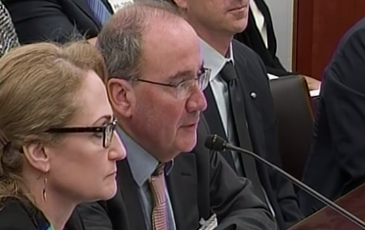 Academic Funding
Academic Funding Preserving SBE Funding — A No-Brainer?

James Olds, assistant director of biological sciences for the NSF, testifies before the CJS subcommittee. Jo Handelsman of the OSTP is at his side.
A few legislators, like Chaka Fattah, an 11-term Democrat from Pennsylvania, have made a name for themselves in Congress as genuine avatars of brain science, whether it’s neuroscience’s granular examination or social sciences’ applications. One speaker at a hearing last Thursday described Fattah as “a tireless champion for neuroscience,” a view endorsed by the subcommittee’s chairman, Texas Republican John Culberson.
Culberson, the Texas Republican who chairs CJS, called neuroscience a “vitally important and emerging field with exciting new developments taking place all the time,” and he thanked Fattah for keeping the “focus” of this committee on the issue. Fattah, for his part, acknowledged that Culberson’s own interests often revolve on space exploration, “but it in no way kept the chairman from “keeping our eyes focused on the greatest scientific that we know of, which is how our brains … actually function.”
“This entire effort,” Fattah said of efforts to increase funding for study of the brain, “has been bipartisan from the beginning.”
Thursday’s oversight hearing on federal investments in neuroscience and neurotechnology took place before the House Appropriation Committee’s Commerce, Justice, Science, and Related Agencies (CJS) subcommittee. Witnesses were drawn from federal agencies that commission research and industry and academic groups that carry it out.
There is a substantial federal investment in brain science. Jo Handelsman, associate director for science at the White House’s Office of Science and Technology Policy, discussed several major efforts in her remarks, including an Interagency Working Group on Neuroscience which combines the work of more than 20 federal agencies, and the two-year-old BRAIN (Brain Research through Advancing Innovative Neurotechnologies) Initiative. The latter includes investments from five federal agencies – NSF, the Intelligence Advanced Research Projects Activity, the Defense Advanced Research Projects Agency, the National Institutes of Health and the Food and Drug Administration — plus a raft of other academic, medical and even commercial partners. The White House proposes increasing funding for BRAIN from this year’s $200 million to $300 million in 2016, and little quibbling has been heard from either major party objecting to the request.
Despite that conviviality on the brain, fault lines remain between the predominantly Republican efforts to reduce or eliminate spending for social and behavioral science and the predominantly Democratic efforts to increase or at least preserve funding. Those tensions were apparent in the witness testimony Thursday and in a brief exchange near the close of the hearing, even though at no point did mention of any disagreements make their way into the record.
One common argument used in proposing to limit spending on social science is that those disciplines are not as important or valuable as ‘harder’ science and technology research, and that money spent on social science therefore comes at the expense of physical or medical science advances.
The witnesses made sure to show how brain science has a role in every National Science Foundation directorate. For example, James Olds, assistant director of biological sciences for NSF, specifically cited the foundation’s many interdisciplinary approaches to brain science in his testimony, such as the Perception, action and Cognition; Cognitive Neuroscience; and Science of Learning programs housed in the Directorate of Social Behavioral and Economic Sciences (SBE), a directorate which in the last three years has routinely taken its lumps come funding time.
In that vein, Olds specifically cited the SBE-funded work of Andrea Chiba at the University of California, San Diego, where researchers are studying how the human brain functions during social interactions and decisions. That’s a more counter-intuitive line of inquiry than it might first seem, he added, since most brain study focuses on neurons and is conducted in the lab – so research subjects are “essentially quarantined from other humans,” Olds said. Chiba’s crew is developing sensors and robotics to study human reactions in a realer-world setting, work that builds and combines research in the social and behavioral sciences along with engineering, materials science, intelligent systems and biology.
Steven E. Hyman, president of the Society for Neuroscience and director of the Stanley Center for Psychiatric Research at the Broad Institute of MIT and Harvard, sounded another defense of the social sciences – that even projects with unusual subjects or odd-sounding titles that have been vetted by the NSF’s peer-review process often return first-class solutions to pressing problems.
Hyman demonstrated by citing research from Texas (Culberson’s home state) and Pennsylvania (Fattah’s home). The latter research at the University of Pennsylvania also pointed out how seemingly silly research, in this case focusing on songbirds, shouldn’t be judged by its subject or seeming distance from important issues. “These birds are a significant model because they learn their precise songs by listening to older birds, with important analogies to how human infants learn language,” Hyman said, adding that the tools employed, such as the blossoming field of optogenetics, pay future dividends in understanding how to understand or even manipulate human brains.
Much of the questions of the witnesses spotlighted either specific brain maladies, such as ALS, Alzheimer’s of traumatic brain injuries, and less on behavioral or cognitive questions. But late in the hearing, Culberson himself opened the door to a defense of SBE.
“What is this device,” he asked rhetorically, holding up a cell phone, “and the instant gratification it brings doing to our kids and the evolution of our minds? This is changing us … it’s altering behavior and it’s really worrisome.”
Olds answered, saying he wasn’t convinced that the IT revolution was going to immediately create long-term changes in the structure of the brain.
“Physical changes,” interjected Culberson. “What about behavioral?”
“I think,” said Olds, “this is an example of why we need research into social, behavioral and economic sciences as well as the basic biological research because this is an area clearly where we’re looking into complex human behavior as it interacts with machines, and that would be SBE.”































































































